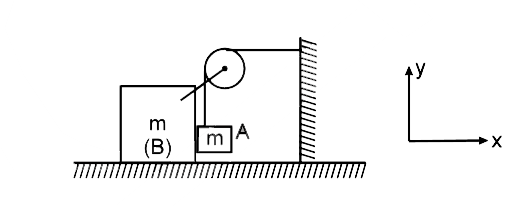In the diagram above, assume that the tabletop is frictionless. Determine the acceleration of the blocks once they're released from rest.
There are two blocks, so we need to draw two free-body diagrams.

To get the acceleration of each one, we use Newton's Second Law, Fnet=ma.

Notice that there are two unknowns, Fy and a , but we can eliminate FT by adding the two equations, and then we can solve for a.

A quicker way of solving for the acceleration is to treat the entire system (blocks plus string) as one object. Since we are only concerned with forces acting on the object, we can ignore tension. The string is part of the object. Then we only need to consider forces acting in the direction of motion (Mg) and forces opposite the direction of motion (none). Our mass in Newton's Second Law becomes M+ m, so Fnet=ma becomes Mg=(M+m)a , giving us the same answer for acceleration.
Topper's Solved these Questions
Similar Questions
Knowledge Check
What is the acceleration of block A when the system is released from rest ?
 Ag/2 downwardsBg/3 downwardsCg/3 upwardsDg/2 upwards.
Ag/2 downwardsBg/3 downwardsCg/3 upwardsDg/2 upwards.Find the acceleration of the block of mass m. Assume pulleys are massless and frictionless.
 Ag/3B2g3Cg2DNone
Ag/3B2g3Cg2DNone
For the following system shown assume that pulley is frictionless, string is massless (m remains on M),
Q. The acceleration of the block A isAmg2M+mB2mg2M+mCmgM+2mDMgM+2m

For the following system shown assume that pulley is frictionless, string is massless (m remains on M),
Q. The acceleration of the block A is
View SolutionIn the system shown in the diagram all surfaces are smooth, pulley and strings are ideal. If −→aA and −→aB are the accelerations of the two blocks, then just after the system is released from rest, then choose correct statement(s) :

View SolutionGiven the setup shown in Fig Block A,B and C have masses mA=M and mB=mC=m. The strings are assumed maseless and unstreichable, and the pulleys frictionless .There is no friction between block B and the support table, but there is friction between blocks B and C, denoted by a given coefficient μ

a . In terms the given find (i) the acceleration of block A and B
b. Suppose the system is released from rest with block C near the right end of block B as shown in the above figure. If the the length L of block B is given, what is the speed of block C as it reached the left end of block B ? Tear the size of C as small
c. If the mass of block A is less then some critical value, the blocks will not accelerate when released from rest. Write down as expression for that critical mass.
View SolutionGiven the setup shown in Fig Block A,B and C have masses mA=M and mB=mC=m. The strings are assumed maseless and unstreichable, and the pulleys frictionless .There is no friction between block B and the support table, but there is friction between blocks B and C, denoted by a given coefficient μ

a . In terms the given find (i) the acceleration of block A and B
b. Suppose the system is released from rest with block C near the right end of block B as shown in the above figure. If the the length L of block B is given, what is the speed of block C as it reached the left end of block B ? Tear the size of C as small
c. If the mass of block A is less then some critical value, the blocks will not accelerate when released from rest. Write down as expression for that critical mass.
View SolutionIn the system shown all the surfaces are frictionless while pulley and string are massless. The mass of block A is 2m and that of block B is m. The acceleration of block B immediately after system is released from rest is

View Solution

